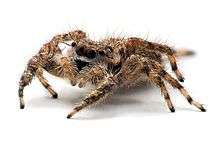Arachnophobia
| Arachnophobia | |
|---|---|
| Synonyms | Arachnephobia[1] |
| Pronunciation |
|
| Specialty | Psychiatry |
Arachnophobia is the fear of spiders and other arachnids such as scorpions.[2]
Signs and symptoms
People with arachnophobia tend to feel uneasy in any area they believe could harbor spiders or that has visible signs of their presence, such as webs. If arachnophobies see a spider, they may not enter the general vicinity until they have overcome the panic attack that is often associated with their phobia. Some people scream, cry, have emotional outbursts, experience trouble breathing, sweat, have heart palpitations, or even faint when they come in contact with an area near spiders or their webs. In some extreme cases, even a picture or a realistic drawing of a spider can trigger intense fear.
Reasons
Arachnophobia may be an exaggerated form of an instinctive response that helped early humans to survive,[3] or a cultural phenomenon that is most common in predominantly European societies.[4]
Evolutionary
An evolutionary reason for the phobia remains unresolved. One view, especially held in evolutionary psychology, is that the presence of venomous spiders led to the evolution of a fear of spiders, or made acquisition of a fear of spiders especially easy. Like all traits, there is variability in the intensity of fear of spiders, and those with more intense fears are classified as phobic. Being relatively small, spiders do not fit the usual criterion for a threat in the animal kingdom where size is a factor, but they can have medically significant venom. However, a phobia is an irrational fear as opposed to a rational fear.[5]
By ensuring that their surroundings were free from spiders, arachnophobes would have had a reduced risk of being bit in ancestral environments, giving them a slight advantage over non-arachnophobes in terms of survival. However, having a disproportionate fear of spiders in comparison to other, potentially dangerous creatures[6] present during Homo sapiens' environment of evolutionary adaptiveness may have had drawbacks.
A 2001 study found that people could detect images of spiders among images of flowers and mushrooms more quickly than they could detect images of flowers or mushrooms among images of spiders. The researchers suggested that this was because fast response to spiders was more relevant to human evolution.[7]
Cultural
The alternative view is that the dangers, such as from spiders, are overrated and not sufficient to influence evolution. Instead, inheriting phobias would have restrictive and debilitating effects upon survival, rather than being an aid. For some communities such as in Papua New Guinea and Cambodia spiders are included in traditional foods. This suggests arachnophobia may be a cultural, rather than genetic trait.[8][9]
Treatments
The fear of spiders can be treated by any of the general techniques suggested for specific phobias. The first line of treatment is systematic desensitization – also known as exposure therapy – which was first described by South African psychiatrist Joseph Wolpe.[10] Before engaging in systematic desensitization, it is common to train the individual with arachnophobia in relaxation techniques, which will help keep the patient calm. Systematic desensitization can be done in vivo (with live spiders) or by getting the individual to imagine situations involving spiders, then modelling interaction with spiders for the person affected and eventually interacting with real spiders. This technique can be effective in just one session.[11]
Recent advances in technology have enabled the use of virtual or augmented reality spiders for use in therapy. These techniques have proven to be effective.[12][13]
Epidemiology
Arachnophobia affects 3.5 to 6.1 percent of the global population.[14]
See also
- Arachnophobia (film)
- Apiphobia (fear of bees)
- Entomophobia (fear of insects)
- Myrmecophobia (fear of ants)
- Zoophobia (fear of animals)
References
- ↑ Patricia Bowen (ed.), Internal Medicine Words, Rayve Productions, 1997, p. 18.
- ↑ Heather Hatfield. "The Fear Factor: Phobias". Webmd.com
- ↑ Friedenberg, J.; Silverman, G. (2005). Cognitive Science: An Introduction to the Study of Mind. SAGE. pp. 244–245. ISBN 1-4129-2568-1. Retrieved 2008-10-11.
- ↑ Davey, G.C.L. (1994). "The "Disgusting" Spider: The Role of Disease and Illness in the Perpetuation of Fear of Spiders". Society and Animals. 2 (1): 17–25. doi:10.1163/156853094X00045.
- ↑ https://www.webmd.com/anxiety-panic/features/fear-factor-phobias#1
- ↑ Gerdes, Antje B.M.; Uhl, Gabriele; Alpers, Georg W. (2009). "Spiders are special: fear and disgust evoked by pictures of arthropods" (PDF). Evolution and Human Behavior. 30: 66–73. doi:10.1016/j.evolhumbehav.2008.08.005.
- ↑ Öhman, A., Flykt, A., & Esteves, F. (2001). "Emotion drives attention: Detecting the snake in the grass". Journal of Experimental Psychology: 130 (3), 466–478.
- ↑ Wagener, Alexandra L.; Zettle, Robert D. (2011). "Targeting Fear of Spiders With Control-, Acceptance-, and Information-Based Approaches" (PDF). The Psychological Record. 61 (1). Archived from the original (PDF) on 2011-06-14.
- ↑ Ohman, A; Mineka, S (2001). "Fears, Phobias, and Preparedness: Toward an Evolved Module of Fear and Fear Learning" (PDF). Psychological Review. 108 (3): 483–522. doi:10.1037/0033-295X.108.3.483. PMID 11488376.
- ↑ WOLPE, J (March 1961). "The systematic desensitization treatment of neuroses". The Journal of Nervous and Mental Disease. 132: 189–203. doi:10.1097/00005053-196103000-00001. PMID 13786444.
- ↑ Ost, L. G. (1989). "One-session treatment for specific phobias". Behaviour research and therapy. 27 (1): 1–7. doi:10.1016/0005-7967(89)90113-7. PMID 2914000.
- ↑ Bouchard, S.; Côté, S.; St-Jacques, J.; Robillard, G.; Renaud, P. (2006). "Effectiveness of virtual reality exposure in the treatment of arachnophobia using 3D games". Technology and Healthcare. 14 (1): 19–27.
- ↑ Kim, J., ed. (2011). Virtual Reality. InTech. ISBN 9789533075181.
- ↑ Schmitt, WJ; Müri, RM (2009). "Neurobiologie der Spinnenphobie". Schweizer Archiv für Neurologie. 160 (8): 352–355. Archived from the original on 23 August 2016.
External links
| Classification |
|---|
- Stiemerling, D. (1973). "Analysis of a spider and monster phobia". Z Psychosom Med Psychoanal (in German). 19 (4): 327–45. PMID 4129447.
- National Geographic: "Fear of Snakes, Spiders Rooted in Evolution, Study Finds"
